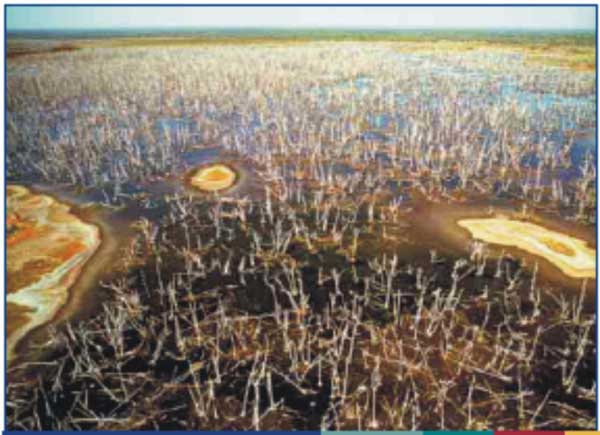What is saline intrusion?
In simple terms saline intrusion is the influx of sea water into an area that is not normally exposed to high salinity levels. This could be the inflow of seawater into a fresh water wetland or a fresh water aquifer. Both are likely to impact estuaries.
What causes saline intrusion?
Breakdown of natural barriers
In some areas natural barriers such as mangroves or sand ridges (cheniers) separate the ocean from wetlands or fresh water habitats. Breaks can be created in these barriers allowing seawater to access the areas behind them. These breaks can occur in a number of was such as naturally from the action of storms or flooding, by human intervention such a dredging for navigation or erosion from boat wash, or by the activities of animals such as feral water buffalo in the Northern Territory which strip vegetation to form of swim channels and wallows.
Rising Sea Levels
As sea levels rise, their saline water will be able to overcome natural barriers to move into low lying areas now dominated by freshwater. Rising sea levels will also push seawater into coastal fresh water aquifers. While this impact may not be noticed on the surface it could affect groundwater that seeps into estuaries.

Figure 1. Saltwater-freshwater interface in: (a) an unconfined (hypothetical) coastal aquifer; and (b) the same aquifer under a sea-level rise scenario. In the sea-level rise scenario, abstraction from the coastal boreholes would be reduced or stopped altogether due to the intrusion of saline water into the aquifer.
Storm Surges
One of the projected impacts of climate change is a potential increase in the number of severe cyclones and or an increase in the intensity of storms in general. Larger storms produce larger storm surges and this combined with a rise in sea level could result in much higher rates of coastal erosion which would in turn impact on the levels of saline intrusion.
Mitigation Actions
Not all actions will increase saline intrusions. It is possible to reduce or prevent seawater from intruding, particularly in areas where the major cause of the intrusion is the breakdown of barriers, by preventing the further loss of barriers or reconstructing damaged barriers. There are many examples of these types of mitigation actions in from the barrages at the mouth of the Murray River to much simpler earthen weirs on rivers in NT1. While these have proven to be effective in some in cases, their long-term impact and there environmental impact and effectiveness in light of climate change and sea level rise is unclear in most cases.
Existing information and Data
Work on the Mary River, in the Northern Territory, has shown that almost 250 km2 of wetlands has been affected due to saline intrusion. The major impact is the death of the salt sensitive vegetation (such as the melaleucas), which is replaced with mudflat vegetation and eventually salt tolerant Mangroves.

Figure 2. Melaleuca Deaths from Saline Intrusion on the Mary River, Northern Territory2.
The Mary River wetlands have been shown to be highly productive and their loss would have an impact not only on local communities dependant on them but also commercial fishing. The key question being addressed by Northern Territory government is whether or not mitigation actions can be cost effective, i.e. will the economic benefits of mitigation outweigh the costs. Initial research suggests that even just taking into account tangible benefits such as fishing and grazing that mitigation will have an economic benefit1.
Key questions and further research needs
- Which estuaries and associated wetlands are sensitive to saline intrusion?
- Will mitigation be practical and cost effective?
- How will saline intrusion impact estuarine health and productivity
Links
More on potential impacts of sea-level rise and climate change on coastal aquifers (UNSW).
Contributor
Geoscience Australia
- Australian Greenhouse Office 2004,‘ Cost-benefit analysis of Mary River salinity mitigation’, Canberra. ↩ ↩
- Bach, C and Hosking, EJ 2002,‘Wetland Monitoring for the Mary River Catchment, Northern Territory ‘, Natural Heritage Trust Project No. 97152, Department of Infrastructure, Planning and Environment, Darwin ↩


